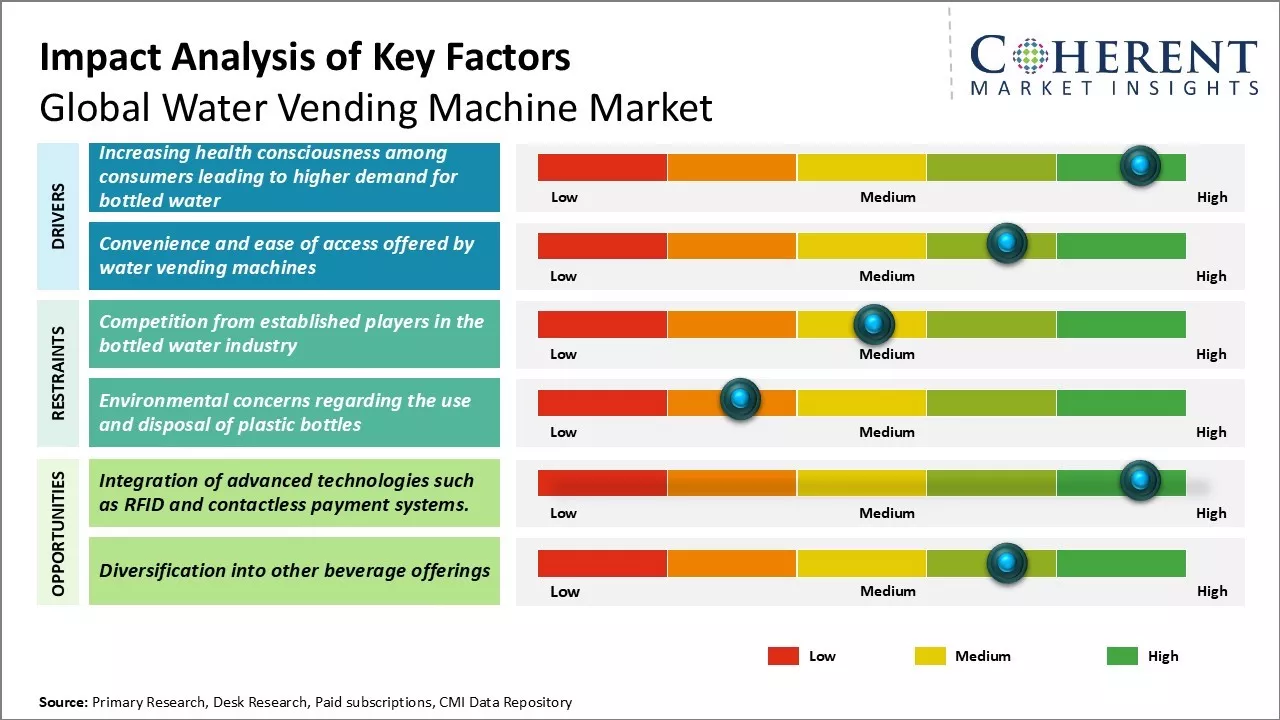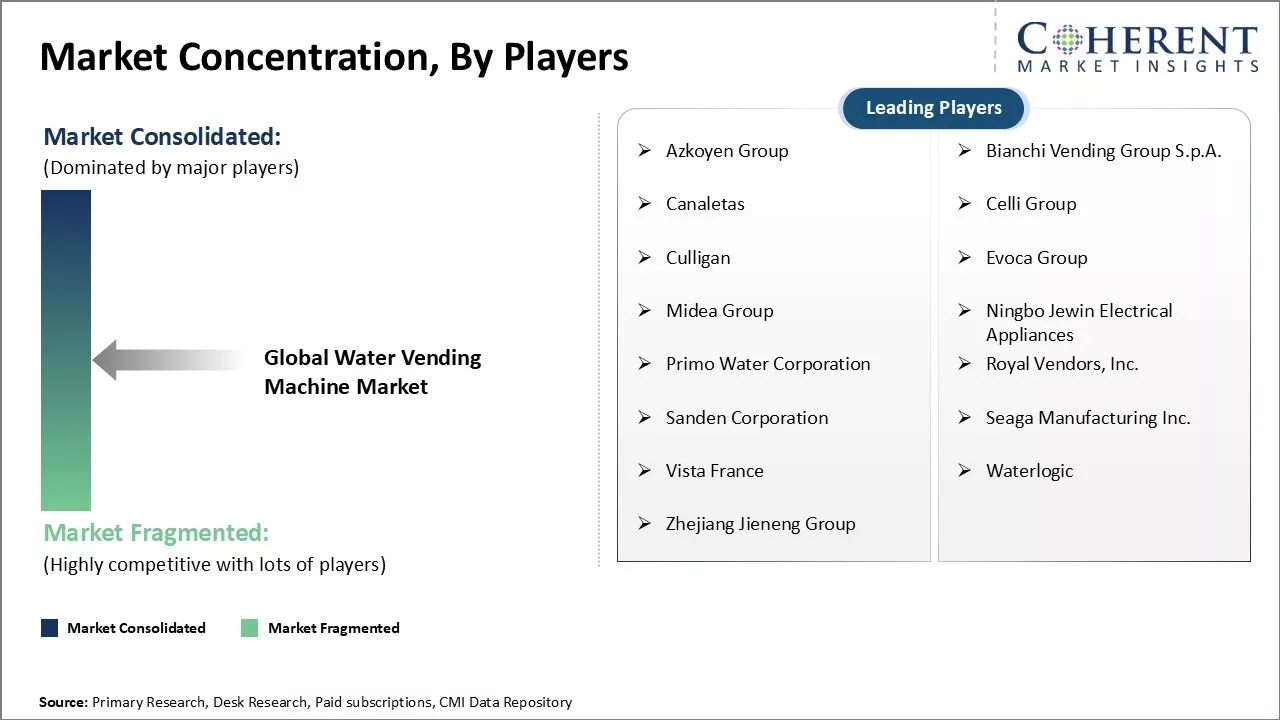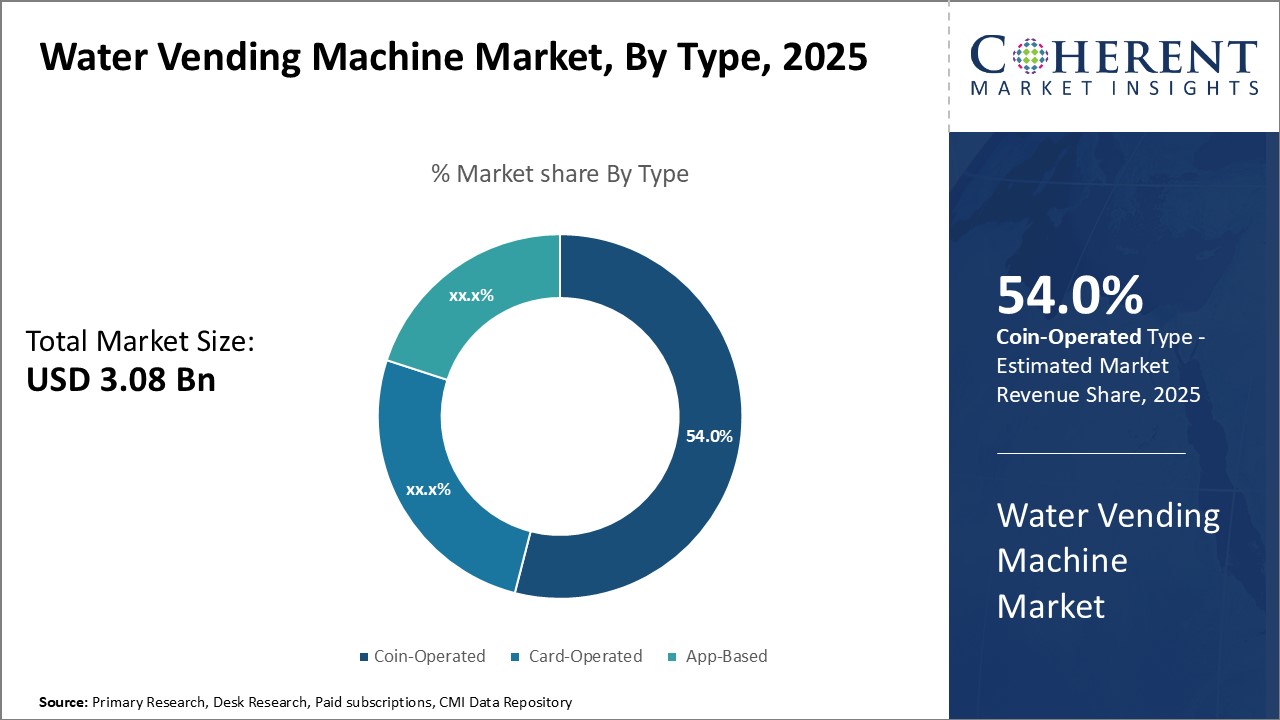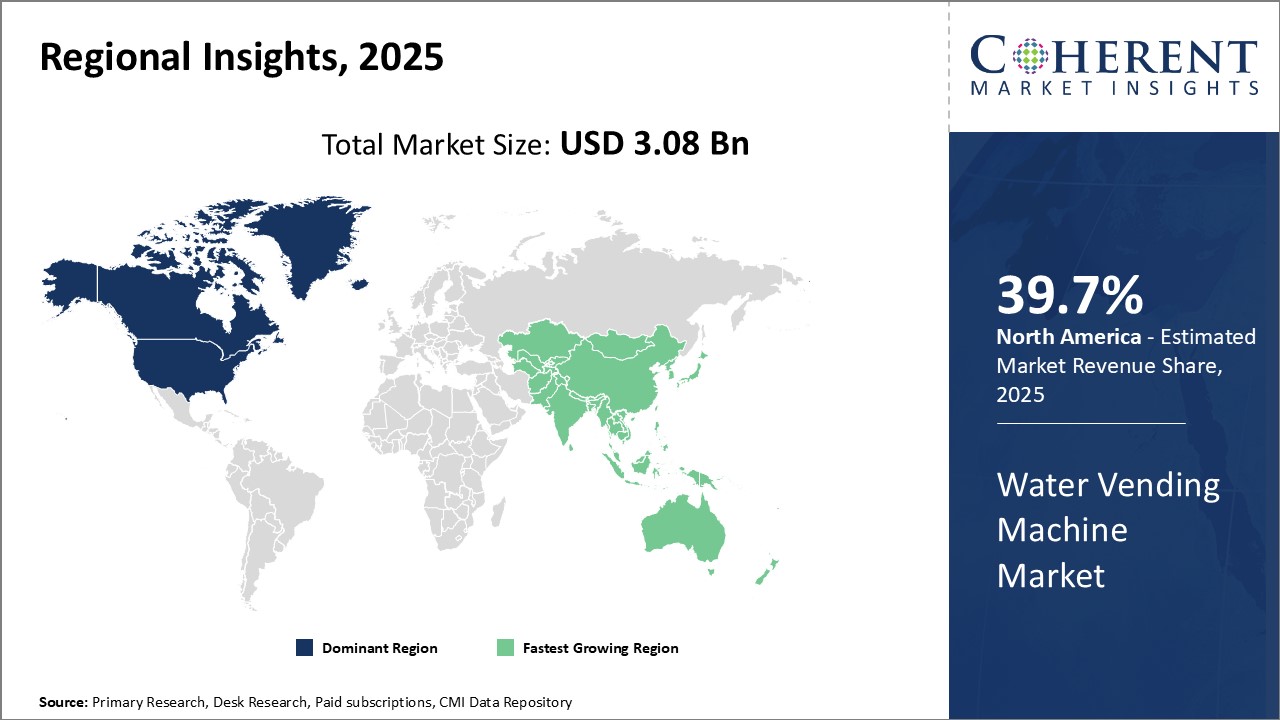Water Vending Machine Market Size and Trends
Global water vending machine market is estimated to be valued at USD 3.08 Billion in 2025 and is expected to reach USD 5.81 Billion by 2032, exhibiting a compound annual growth rate (CAGR) of 9.5% from 2025 to 2032.

Discover market dynamics shaping the industry: Download Free Sample
Rising awareness about health benefits of drinking purified water and shortage of drinking water in many parts of the world can boost demand for water vending machines globally. Water vending machines provide an affordable and accessible solution for obtaining purified drinking water. As populations grow and water stress increases in various regions, water vending machines are becoming a popular option for consumers looking to supplement their water intake with purified alternatives. Various technological advancements in water treatment and dispensing systems are also supporting the steady expansion of the water vending machine market during the forecast period.
Market Driver - Increasing health consciousness among consumers leading to higher demand for bottled water
Rising consumer awareness about their health and hygiene can boost demand for pure and safe drinking water. People are increasingly conscious about the quality of water these consume on a daily basis. Fast paced urban lifestyles and lack of access to safe drinking water sources in many office complexes, apartment buildings or public spaces can boost demand for bottled water. Dehydration and related health issues are becoming more common in metro cities due to lack of fresh water intake. Busy professionals and students find it difficult to carry heavy bottles from home or restaurants. Demand for easily accessible purified drinking water can be efficiently met through water vending machines which are installed at several hotspots like railways stations, shopping malls, hospitals, and others. These machines offer still as well as flavored water options in BPA free reusable bottles of varying sizes suitable for single users as well as groups.
Presence of vending machines alleviates concerns around sanitary conditions during production and storage of bottled water. With growing awareness about health, importance of hydration and environment sustainability, there will be huge demand for purified dispensed water from vending points. Major brands Azkoyen Group, Bianchi Vending Group S.p.A., Canaletas, Celli Group, Culligan, etc. are also promoting their vended water offerings through innovative technologies and attractive packaging targeted at conscious urban consumers.
Market Concentration and Competitive Landscape

Get actionable strategies to beat competition: Download Free Sample
Convenience and ease of access offered by water vending machines
Water vending machines have elegantly addressed these issues by providing on-the-go availability of purified water right at the point of use. Their installations at locations with maximum footfall like airports, railway stations, parks, educational institutions, make it extremely convenient for people to quench thirst anytime without having to carry heavy bottles or look for water sources.
Apart from basic still water, many advanced machines also offer flavored variants, room temperature or chilled options using separate dispensing columns. Touch screen interfaces with intuitive menus make selection and payment most hassle-free even for first time users. Contactless payment options through cards or Digital Payments further enhance the accessibility aspect. Customers appreciate features like illuminated displays visible even after dark and motion sensor based automatic dispensing, thus, eliminating waiting times.
Water vending machines have become an essential amenity in high-traffic areas due to their ability to provide clean drinking water conveniently and promptly. Factors such as independence from bottled water supplies, compact installation footprints, and round-the-clock availability enhance their reliability and drive global adoption. A vast network of water vending machine providers ensures that local demands are met across geographies. With increasing urbanization and mobility, the market potential for these solutions remains highly promising.
Key Takeaways from Analyst:
Global water vending machine market growth is driven by increasing demand for purified drinking water and rising health consciousness among consumers globally. Stringent safety and quality standards enforced by regulatory bodies can also boost the installation of water vending machines that can filter and purify water effectively. As North America remains the dominant, owing to rising disposable incomes and growing urbanization in countries like U.S. and Canada. As well as the Asia Pacific is the fastest growing market.
High initial investment cost for installation and maintenance of water vending machines can hamper the market expansion. Moreover, availability of alternative options like bottled water restricts the complete reliance on vended water. Ongoing initiatives to improve water infrastructure in developing nations and increasing adoption of advanced technologies like touch screens and cashless payment can offer new opportunities for market players.
Demand for premium purified water has witnessed an upward trend especially in urban areas, which works in favor of players offering additional features like different water temperatures and aromas. On the supply side, manufacturers are innovating to develop energy-efficient and environmental-friendly water dispensing solutions tailored to meet specific consumer demands in different geographical locations.
Market Challenge - Competition from established players in the bottled water industry
Global water vending machine market growth can be hampered due to strong competition from established players in the bottled water industry. These sell their products at relatively low prices, thus, making it difficult for new water vending machine operators to compete. Bottled water is also more convenient for consumers as people can purchase them from any retail store whereas vending machines have limited geographic reach. Moreover, bottled water companies spend heavily on promotions and celebrity endorsements to boost awareness and loyalty for their brands among consumers. For new entrants, it is a challenge to gain consumer trust and compete on price while establishing complex refill and servicing operations for water vending machines. These will need to differentiate strongly on aspects like sustainability, localized availability, and additional value-added services to counter the competitive pressures.
Opportunity- Integration of advanced technologies such as RFID and contactless payment systems
The integration of advanced technologies can offer growth opportunity for global water vending machine market. The introduction of features like RFID cards, contactless payments through smartphones, and interactive touchscreens can improve the consumer experience. RFID cards can enable accurate tracking of usage for water vending machine and automatic billing. Contactless payments through mobile wallets eliminate the need to carry cash, making the purchase more convenient. Interactive touchscreens allowing consumers to customize water options by temperature, addition of minerals, and others, and access additional information can increase adoption of water vending machines. Such technologies also facilitate data collection about usage patterns, thus, aiding better demand forecasting and supply chain management for operators. As consumers globally become more technology-savvy, innovative features will help differentiate water vending solutions and drive greater uptake in both commercial and residential applications. Equipment suppliers and service providers must focus on integrating the latest innovations to tap into this opportunity.
For instance, in April 2023, Oasis International, a global leader in water dispensing solutions, launched a new series of water vending machines designed to be both energy-efficient and environmentally sustainable. These machines incorporate advanced water purification technologies and smart features aimed at optimizing water usage while minimizing their environmental footprint.

Discover high revenue pocket segments and roadmap to it: Download Free Sample
Insights By Type - Consumer convenience drives coin-operated segment
In terms of type, coin-operated segment is estimated to contribute the highest market share of 54.0% in 2025, owing to its convenience for consumers. Coin-operated machines allow users to purchase water without needing a card or app, making the transaction very simple. Coin mechanisms are also quite durable and reliable as compared to card readers or app interfaces, reducing maintenance costs for machine owners.
The widespread acceptance and familiarity of coins as a payment method also helps coin machines. Most consumers are accustomed to using coins in other vending and laundry machines so there is a certain level of comfort. Coins do not require setting up accounts or entering sensitive payment details like cards. This consumer preference for the familiarity and security of cash plays a big role in coin-operated' leadership position.
Many users just need affordable drinking water quickly without hassles. Coin machines fulfill this core demand better than alternatives by having uncomplicated purchase processes optimized for transient usage. Their barebones approach resonates well with price-conscious customers who prioritize speed and convenience over extras.
Insights By Installation - Indoor installations attract high traffic areas
In terms of installation, indoor segment is estimated to contribute the highest market share of 39.4% in 2025, due to their appeal for high foot traffic locations. Indoor machines benefit from being situated in areas with a constant flow of potential customers. Popular installation spots include office buildings, schools, transportation hubs, malls and other commercial spaces.
Indoor units have the advantage of not being exposed to extreme weather, helping to ensure thse experience fewer breakdowns from environmental factors like heat, cold or rain. This reliability is important for locations counting on the machines to serve many users consistently. Indoor machines also allow for electrical connections, removing the need for costly solar panels or generators as a power source. Electrical hookups provide a more stable long-term energy solution.
Security is another benefit of indoor placement, as machines have less risk of vandalism. Valuables like coins and card payment systems are better protected inside. Many individuals purchase water simply because vending units are conveniently located along their routes, boosting per-unit sales volume versus outdoor models.
Insights By End User- Home use convenience powers residential segment dominance
Among end user, residential segment is estimated to contribute the highest market share of 56.6% in 2025, due to satisfying household hydration needs conveniently. Busy families appreciate having on-demand water access at home without trips to stores. Units fit easily into homes, taking up little space yet fulfilling the task of regularly supplying drinking water. This serves busy lifestyles well by saving time that would otherwise be spent shopping or hauling bottled water.
Vending machines let users customize filtration that satisfies taste and health preferences better than tap water in some areas. Filters remove contaminants and minerals for pure refreshment. Homemade or store-bought water sometimes sits around too long, risking spoilage - but vending units produce fresh batches on demand.
For instance, o In January 2021, Avalon Water Coolers, a leading manufacturer of water dispensers and coolers in the United States, launched a touchless water dispenser that uses motion-activated sensors. This innovative product promotes hygiene by allowing users to dispense water without physical contact with the machine, reducing the risk of spreading germs or illnesses. Avalon Water Coolers has been providing high-quality water solutions for homes and offices since its establishment, focusing on delivering reliable, efficient, and user-friendly products. The introduction of this touchless water dispenser demonstrates Avalon's commitment to adapting to evolving consumer needs and providing cutting-edge solutions for safe and convenient access to drinking water.
Regional Insights

Need a Different Region or Segment? Download Free Sample
North America dominates the global water vending machine market with 39.7% in 2025. The region has a well-established market for bottled water consumption as well as infrastructure to support automatic water dispensers across commercial and public spaces. Major cities in the U.S and Canada have witnessed high demand for point-of-use water vending machines from offices, schools, hospitals and retail locations, aiming to provide healthy drinking options. The region is also a prominent producer of several brands of bottled water, which retailers leverage through strategic partnerships with water vending machine operators.
Asia Pacific emerges as the fastest growing regional market. Rapid urbanization and increasing health awareness about the benefits of pure drinking water have boosted uptake of water vending machines, especially in densely populated cities across China, India and Southeast Asian nations. Several local players as well as global brands witness immense potential in these developing economies and are actively expanding their presence through joint ventures and acquisitions. Growing middle class has higher disposable incomes to spend on pure drinking water alternatives available on-demand from vending points. This has encouraged significant investments from international water treatment companies and vending machine manufacturers into the region.
Western Europe remains an traditional market as citizens are environmentally conscious and prefer ecologically-friendly options over single-use plastic water bottles. Countries like Germany and the U.K. have policy support for water reuse, which water vending machine operators’ leverage through innovative business models and pricing strategies.
Market Report Scope
Water Vending Machine Market Report Coverage
| Report Coverage | Details | ||
|---|---|---|---|
| Base Year: | 2024 | Market Size in 2025: | USD 3.08 Bn |
| Historical Data for: | 2020 To 2024 | Forecast Period: | 2025 To 2032 |
| Forecast Period 2025 to 2032 CAGR: | 9.5% | 2032 Value Projection: | USD 5.81 Bn |
| Geographies covered: |
|
||
| Segments covered: |
|
||
| Companies covered: |
Azkoyen Group, Bianchi Vending Group S.p.A., Canaletas, Celli Group, Culligan, Evoca Group, Midea Group, Ningbo Jewin Electrical Appliances, Primo Water Corporation, Royal Vendors, Inc., Sanden Corporation, Seaga Manufacturing Inc., Vista France, Waterlogic, and Zhejiang Jieneng Group |
||
| Growth Drivers: |
|
||
| Restraints & Challenges: |
|
||
Uncover macros and micros vetted on 75+ parameters: Get instant access to report
Water Vending Machine Industry News
- In July 2023, Bevi, a leading provider of smart water vending machines, launched its latest model featuring improved touchscreen technology, cloud-based management, and enhanced water filtration capabilities. The new machine is designed to provide a seamless and customizable hydration experience for users.
- In May 2023, Aqua Libre, a water technology company, unveiled its latest line of Internet of Things (IoT)-enabled water vending kiosks. These kiosks offer remote monitoring, real-time data analytics, and integrated payment systems to enhance the user experience and operational efficiency for businesses and communities.
- In August 2022, Aqua Clara International launched its Aqua Clara Water ATM, designed to provide purified drinking water using reverse osmosis technology. This machine is aimed at improving access to clean water in communities.
- In March 2021, Ningbo Lamo Drink Equipment Technology Co., Ltd., a leading manufacturer specializing in water dispensers and purifiers, launched a smart water vending machine equipped with facial recognition and mobile payment options. This innovative machine enhances user convenience and security, reflecting Lamo's commitment to providing advanced solutions for accessible and safe drinking water. Established in 2002, Ningbo Lamo has rapidly developed a reputation for quality and innovation in the water treatment industry.
*Definition: Global water vending machine market consists of devices that dispense purified drinking water on-demand for self-service purchase. Generally, coin or bill operated, water vending machines allow consumers to easily access cold, hot or ambient temperature water in bottles or personal containers without needing to transport bottled water. As portable units, water vending machines are commonly placed in public locations like malls, airports, hospitals and offices to provide a hygienic and cost-effective means for hydration.
Market Segmentation
- Type Insights (Revenue, USD Bn, 2020 - 2032)
-
- Coin-Operated
- Card-Operated
- App-Based
- Installation Insights (Revenue, USD Bn, 2020 - 2032)
-
- Indoor
- Outdoor
- End User Insights (Revenue, USD Bn, 2020 - 2032)
-
- Residential
- Commercial
- Institutional
- Regional Insights (Revenue, USD Bn 2020 - 2032)
-
- North America
- U.S.
- Canada
- Latin America
- Brazil
- Argentina
- Mexico
- Rest of Latin America
- Europe
- Germany
- U.K.
- Spain
- France
- Italy
- Russia
- Rest of Europe
- Asia Pacific
- China
- India
- Japan
- Australia
- South Korea
- ASEAN
- Rest of Asia Pacific
- Middle East
- GCC Countries
- Israel
- Rest of Middle East
- Africa
- South Africa
- North Africa
- Central Africa
- North America
- Key Players Insights
- Azkoyen Group
- Bianchi Vending Group S.p.A.
- Canaletas
- Celli Group
- Culligan
- Evoca Group
- Midea Group
- Ningbo Jewin Electrical Appliances
- Primo Water Corporation
- Royal Vendors, Inc.
- Sanden Corporation
- Seaga Manufacturing Inc.
- Vista France
- Waterlogic
- Zhejiang Jieneng Group
Share
Share
About Author
Ramprasad Bhute is a Senior Research Consultant with over 6 years of experience in market research and business consulting. He manages consulting and market research projects centered on go-to-market strategy, opportunity analysis, competitive landscape, and market size estimation and forecasting. He also advises clients on identifying and targeting absolute opportunities to penetrate untapped markets.
Missing comfort of reading report in your local language? Find your preferred language :
Transform your Strategy with Exclusive Trending Reports :
Frequently Asked Questions
EXISTING CLIENTELE
Joining thousands of companies around the world committed to making the Excellent Business Solutions.
View All Our Clients
